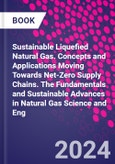Sustainable Liquefied Natural Gas: Concepts and Applications Moving Towards Net Zero Supply Chains, the latest release in The Fundamentals and Sustainable Advances in Natural Gas Science and Engineering series, delivers many of the technical fundamentals needed in the natural gas industry with an additional sustainability lens. Introductory topics include liquefication and separation technology. Advanced applications include improving operational efficiency for carriers and cargo shipping schedules, exploiting cold energy for regasification operations, and an outlook on ways to further reduce emissions.
Supported by corporate and academic contributors along with two well-distinguished editors, this book provides today's natural gas engineers the knowledge to adjust liquefied natural gas operations in a more environmentally sustainable way.
Please Note: This is an On Demand product, delivery may take up to 11 working days after payment has been received.
Table of Contents
Preface
1. LNG: An Evolving Industry with Net-Zero Challenges
Section One: Natural gas liquefaction
2. The evolution of global LNG supply chains: A Review
3. Natural Gas Liquefaction Technologies and Their Uptake in Floating LNG Facilities
4. The core liquefaction facility in FLNG: spiral-wound heat exchanger
5. Australian LNG sector: Struggling to Achieve Commercial and Environmental Sustainability or Community Satisfaction
6. Supersonic separation technology for natural gas dehydration in LNG plants
Section Two: LNG shipping and offshore storage facilities
7. LNG carriers and FSRU: opportunities to improve their operational efficiency
8. Sustainable LNG deliveries and FSRU operations: planning and scheduling simulations
9. Liquefied Natural Gas Cold Energy Utilization Technology Process Efficiency for Floating Regasification Facilities
Section Three: Onshore Storage and Regasification
10. Dynamic simulation models for an LNG storage tank
11. Stratification and rollover behavior of liquefied natural gas in storage tanks
12. LNG rollover monitoring and control associated with floating storage and regasification units (FSRU)
Section Four: Small-scale LNG facilities and operations
13. Safety of LNG bunkering operations and facilities
14. Exploiting cold energy associated with LNG regasification processes
Section Five: LNG markets and utilization
15. LNG Marketization progress in China and its LNG price indexes
16. Carbon-neutral LNG cargoes: a potentially valuable concept requiring improved transparency








